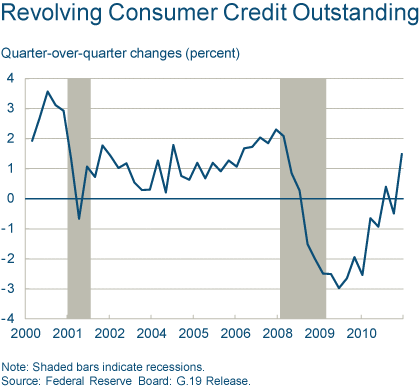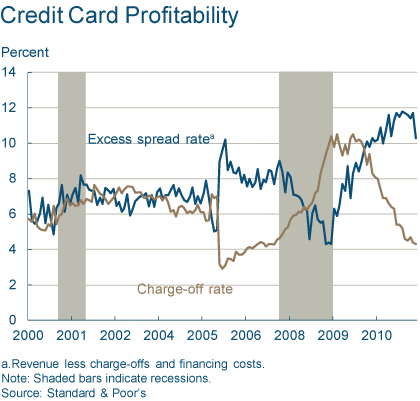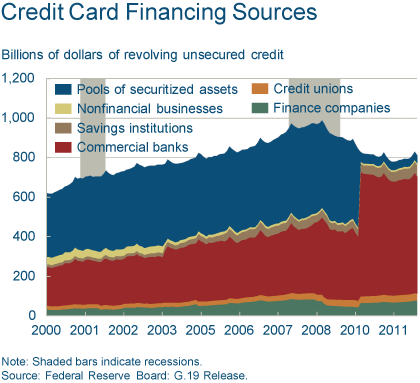Increased Lending, Higher Balances Lead to Lower Credit Card APRs

That is how two Cleveland Fed researchers — O. Emre Ergungor and Patricia Waiwood — interpret the fall of credit card interest rates in the past two years. There is not a mention in their short release of either of the two big payment-card-related legislations passed during that period — the Card Act of 2009 and the Durbin Amendment to the Dodd-Frank act — both of which had a huge impact on the way credit card issuers do business.
While I don’t think that anything that the card issuers have done in the past couple of years can be analyzed in isolation of the accompanying regulatory developments, Ergungor and Waiwood have produced several charts that help us make better sense of recent trends. Let me share them with you.
Outstanding Credit and Interest Rates
Here are the credit card interest rates, presented by the researchers as a spread over one-year treasury notes, since 2000:

So we can see that the interest rates have fallen from their post-Lehman highs, but are still very high by recent (and historical) standards. And now here is the outstanding revolving credit (mostly credit card balances) for the same period, shown as a quarter-over-quarter change:

We can clearly see the inverse relationship between the changes in the interest rate and the outstanding revolving credit, especially in the two recessions covered in these charts. What is less clear, however, is whether the growth in credit card balances will be as robust in the coming months as its decline was steep in the post-Lehman period. The latest Federal Reserve data show declines.
Issuers’ Profits Grow as Charge-offs Decline
We already knew that the profitability of credit card portfolios was growing again which, after all, is what should be happening when delinquency and charge-off rates are moving into record-low territories. And sure enough, profits, measured by the excess spread rate, are as high as they’ve been in at least a decade:

As the charge-offs are expected to keep falling in the coming months and to dip below the four-percent threshold sometime by the end of this year, the issuers’ profits are likely to improve even further.
Moreover, the researchers point out, in the post-Lehman months, “banks could only fund new credit card debt on their balance sheets,” whereas “the market for securitized credit card receivables seized up.” The shift is indeed striking:

I think Ergungor and Waiwood may be overly concerned with “the virtual disappearance of an important funding source.” After all, as they themselves point out, the balance sheet lending is likely to lead “to more responsible lending and sound banking” and that can’t be bad.
The Takeaway
Given the magnitude of the 2008 financial crisis, it may not be entirely impossible that its lingering effects are sufficient to explain the fact that credit card interest rates are as high as they are, even as charge-offs are in record-low territory and keep falling and issuers’ profitability is at record-high levels. And yet, it is just as unlikely that the CARD Act and, perhaps to an even greater degree, the Durbin Amendment, should have had nothing to do with it. After all, we know that issuers are looking hard everywhere they can think of for potential sources of new revenue to replace the lost debit interchange income. Credit cards must have been one of the first items on their list.
Image credit: Etsystatic.com.



Well, the lower the credit card interest rates, the more people want to use them, that much makes perfect sense to me. So there is no surprise here.
The most interesting chart to me is the one that shows the rising profitability of credit card issuers. Not only are they now very high, but they are higher than in the boom years 2005 – 2006.
So it looks like credit card borrowing is rising very fast once again. Couple that with student loans getting out of control and you have the make-up of a future crisis.
I agree and it is the student debt that will be the biggest problem next time around. There is not much time to fix it, before it explodes, though.
“[B]anks could only fund new credit card debt on their balance sheets,” whereas “the market for securitized credit card receivables seized up.”
This is a revealing chart to see. It tells you that, if banks didn’t get access to capital, they couldn’t function at all.
So the issuers’ profits are already at record levels and are set to grow even higher as the chargeoffs keep falling. And yet they keep complaining about the interchange fees. If anything, these charts show that the interchange can be lowered further.
High as interest rates are, they are inevitably going to go up, because most issuers now use variable APRs, which are linked to the Fed’s funds rate, which is now at zero. When and if the Fed begins to raise its rate, all variable APRs will rise accordingly. Of course, that is not likely to happen anytime soon, but that’s a different story.
Good point. I would add that the fact that credit card APRs are as high as they are at a time when the Fed’s rate is at zero goes some way toward explaining why the issuers’profits are skyrocketing.
Great info, thanks for all the work!
So it looks like it is possible to have some regulation in place and for banks to make profits, even in a recession. The banks are doing even better now than before the crisis.